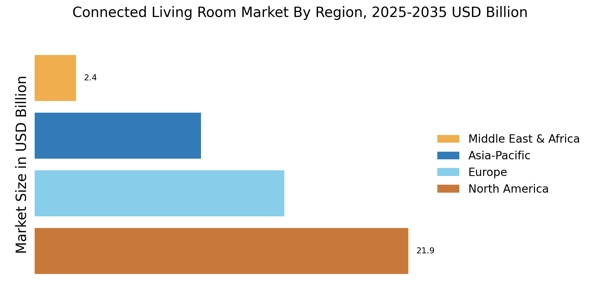The Connected Living Room Market is currently characterized by a dynamic competitive landscape, driven by rapid technological advancements and evolving consumer preferences. Major players such as Amazon (US), Google (US), and Samsung (KR) are at the forefront, each adopting distinct strategies to enhance their market positioning. Amazon (US) focuses on integrating its Alexa ecosystem into various devices, thereby fostering a seamless user experience. Google (US), on the other hand, emphasizes its Google Assistant and Chromecast technologies, aiming to create a cohesive smart home environment. Samsung (KR) leverages its extensive portfolio of smart appliances and televisions, positioning itself as a leader in connected home solutions. Collectively, these strategies not only enhance user engagement but also intensify competition, as companies vie for dominance in an increasingly interconnected market.
In terms of business tactics, companies are increasingly localizing manufacturing and optimizing supply chains to enhance efficiency and reduce costs. The Connected Living Room Market appears moderately fragmented, with a mix of established players and emerging startups. This structure allows for diverse offerings, yet the influence of key players remains substantial, as they set industry standards and drive innovation. The competitive dynamics are further complicated by the rapid pace of technological change, compelling companies to adapt swiftly to maintain relevance.
In August 2025, Amazon (US) announced the launch of its new line of smart home devices that integrate advanced AI capabilities, enhancing user interaction and personalization. This strategic move underscores Amazon's commitment to innovation and its intent to solidify its position as a leader in the connected living room space. By leveraging AI, Amazon aims to provide a more intuitive user experience, potentially increasing customer loyalty and market share.
Similarly, in September 2025, Google (US) unveiled a partnership with several leading smart appliance manufacturers to create a unified platform for smart home devices. This collaboration is significant as it not only expands Google's ecosystem but also enhances interoperability among devices, which is a critical factor for consumers. By fostering a more integrated environment, Google positions itself as a central player in the connected living room market, likely increasing its competitive edge.
In October 2025, Samsung (KR) revealed its plans to invest heavily in sustainable technology for its smart home products. This initiative reflects a growing trend towards sustainability in consumer electronics, appealing to environmentally conscious consumers. By prioritizing eco-friendly practices, Samsung not only differentiates itself from competitors but also aligns with global sustainability goals, potentially enhancing its brand reputation and market appeal.
As of October 2025, the competitive trends in the Connected Living Room Market are increasingly defined by digitalization, sustainability, and AI integration. Strategic alliances are becoming more prevalent, as companies recognize the value of collaboration in enhancing product offerings and market reach. Looking ahead, competitive differentiation is likely to evolve from traditional price-based strategies to a focus on innovation, technological advancement, and supply chain reliability. This shift suggests that companies must not only invest in cutting-edge technology but also prioritize sustainable practices to meet the demands of a discerning consumer base.

















Leave a Comment